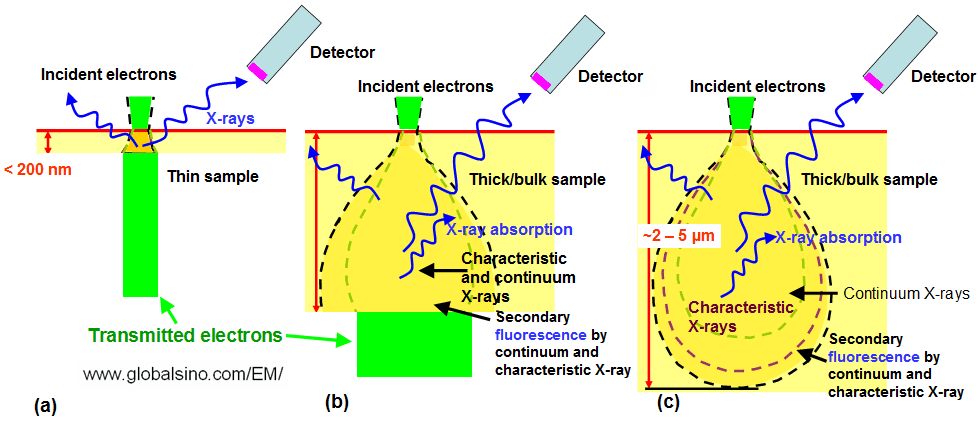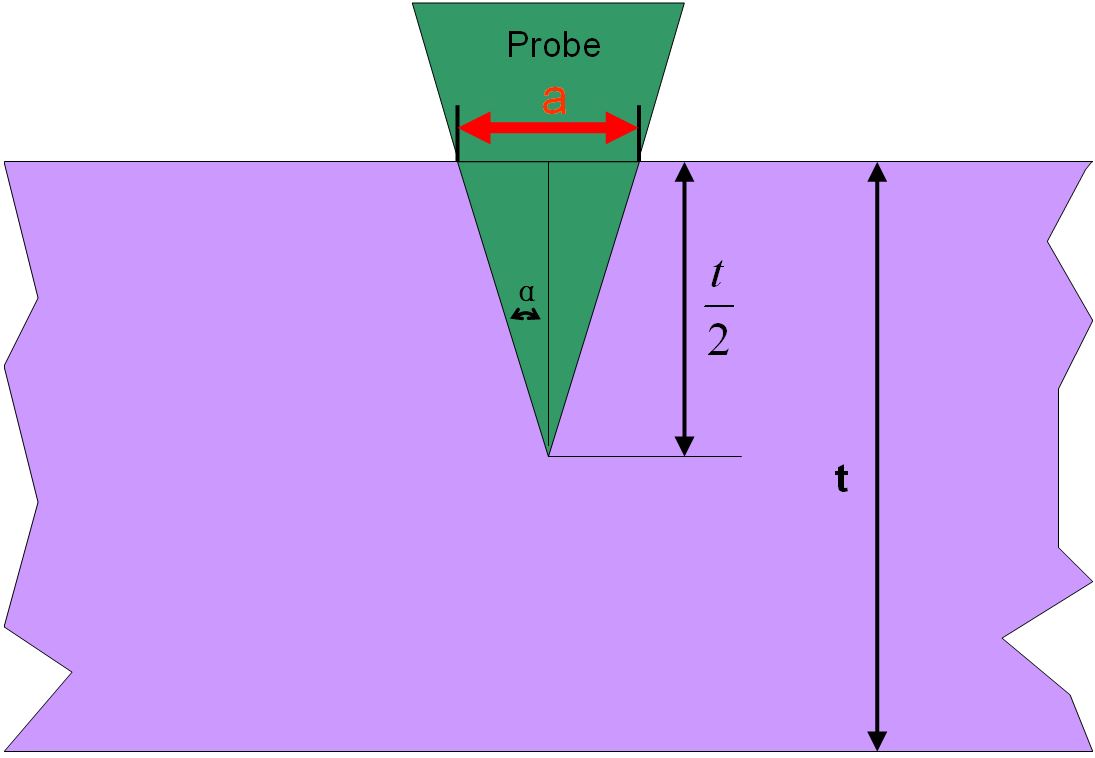=================================================================================
The spatial resolution of EDS measurements depends on the sample thickness significantly. In 1973, it was experimentally demonstrated that thin samples provided much greater spatial resolution in a qualitative electron probe microanalysis by Lorimer and Champness, when they were working on an orthopyroxene from the Stillwater complex, Montana. Actually, the main advantage of using a thin specimen for x-ray microanalysis are:
i) The improved spatial resolution over that obtainable in a bulk specimen,
ii) X-ray absorption and secondary fluorescence are minimal,
iii) The measured intensity is, to a first approximation, the same as the generated intensity.
Figure 3782a shows the schematic illustration of the interaction volume differences in samples in different thicknesses. This differences dramatically influence the spatial resolution, for instance, in a thin sample the spatial resolution for EDS analysis is significantly greater than those in a thick and bulk samples. No large, bell-shaped region is produced by the diffusion of the electron probe underneath the surface of the sample in the thin sample. The interaction volume in the thin sample is just the neck of the bell-shaped region in the thick sample. The size of the neck is approximately equal to the diameter of the incident electron beam. The spatial resolution in the thin sample can be up to five orders of magnitude greater than that in a very thick sample or bulk. Because of the deep penetration and lateral broadening of high-energy electrons in bulk materials, the region of x-ray emission is about 1 μm in diameter, which is the typical resolution of SEM-EDS measurements. It should be mentioned that in a thick or bulk sample X-ray absorption and fluorescence will not only affect the spatial resolution of EDS measurements but also induce analysis artifacts.

Figure 3782a. Schematic illustration of the interactions of the accelerating electrons
with thin, thick, and bulk samples and the corresponding x-ray generations.
On the other hand, in a thin TEM film, beam broadening, depending on the film thickness, still affects the EDS spatial resolution. EDS performed in STEM mode allows nanoanalysis in higher spatial resolution than in SEM mode because of smaller interaction volume, resulting from:
i) Very small electron probes,
ii) Very thin specimens.
Furthermore, the spatial resolution of the measurements in STEM mode can be estimated by the diameter of the probe irradiation on the specimen. Assuming the thickness of the specimen is t, then the spatial resolution is given by (see Figure 3782b):
 -------------------------------- [3782a] -------------------------------- [3782a]
where,
α -- The convergence semiangle.

Figure 3782b. Diameter of the probe irradiation with specimen thickness t. |
For instance, Figure 3782c shows the spatial resolutions at convergence semiangles 7 and 15 mrad, respectively, based on Equation 3782a. Note that such convergence semiangles are used in many TEM systems.
| Figure 3782c. Spatial resolutions at convergence semiangles 7 and 15 mrad, respectively, based on Equation 3782a. |
In SEM mode, the EDS spatial resolution depends mainly on the beam size and the interaction volume due to elastic and inelastic scattering. A single incident electron may be scattered many times, with large changes in its trajectory, so that the X-rays emitted from later scattering events may occur some distance from the location of the electron beam. The radius (r) of the interaction volume from which X-Rays are generated is given by,
 -------------------- [3782b] -------------------- [3782b]
where,
ρ -- The material density,
E0 -- The incident beam energy (keV),
Ec -- The critical
excitation energy for the characteristic X-Ray of interest.
As discussed above, spatial resolution can be improved by small probes and thin specimens. However, these conditions are exactly the opposite of those required to obtain high count rates.
|